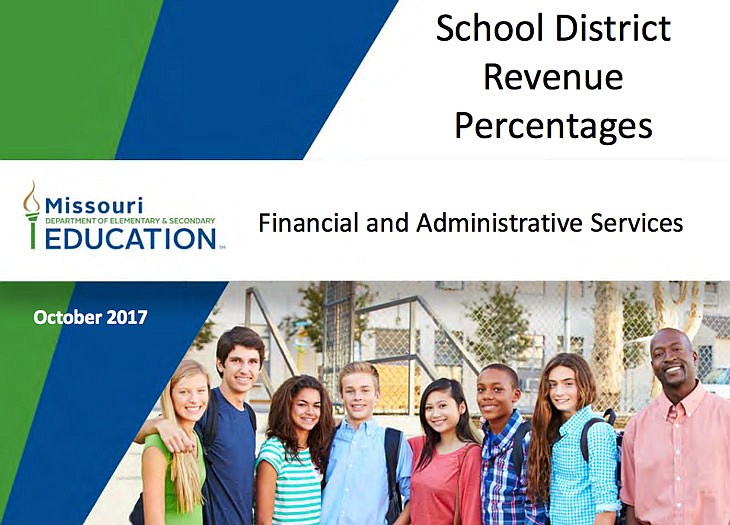Missouri's education department released a report Tuesday showing compared to a decade ago, more school districts in the state are receiving a greater share of money from local sources instead of state and federal funds.
What that exactly means is a little more subjective.
"It depends on your perspective," Brent Ghan said on the correct share of a district's budget ought to come from one source versus another.
Ghan is the deputy executive director of the Missouri School Boards Association. After the state's Department of Elementary and Secondary Education released its "School District Revenue Percentages" report Tuesday at the department's monthly board meeting, the MSBA tweeted "Missouri ranks 4th in the nation in percentage of local revenue for schools, 48th in percentage of state revenue according to DESE data."
The MSBA also tweeted "DESE data shows local revenue for schools is 55%, state revenue is 35%, federal is 9%, but percentages for local districts vary."
"What that means is that as a state, we are much more heavily dependent on local sources of revenue," Ghan said.
A summary at the end of DESE's report details that in the 2005-06 school year, 138 school districts drew more than 50 percent of their revenues from local sources, like tax levies.
In the 2015-16 school year - the most recent year for which data was available - the number of school districts depending more on local sources had grown to 170, out of the 518 districts in the state.
Also in 2015-16, 132 school districts in the state drew more than 50 percent of their revenue from state sources, compared to 137 districts 10 years before.
"One of the issues with being so heavily dependent on local revenue for sources of our funding, there is inherently some inequity that exists across the state," Ghan said, because the ability to raise revenue varies from district to district based on how much taxable property is located within a district's boundaries.
"Not every school district has a nuclear power plant," he said, citing South Callaway School District as an example.
The idea of the state's education formula is to help combat this kind of inequity.
Roger Dorson said being more dependent on one source of funding versus another also presents differences in how districts manage their money. Dorson is the deputy commissioner in DESE's Division of Financial and Administrative Services.
He said a district more reliant on local taxes gets most of its money at the beginning of the calendar year, after property taxes are collected in December. A district that receives a larger share of its revenue from the state gets more of its money spread out on a monthly basis.
"You've got to be careful that you don't deplete your cash flow, to make sure you can pay teachers, pay your vendors and pay all the people you need to pay at the end of the calendar year," Blair Oaks R-2's Superintendent Jim Jones said of being more reliant on local taxes.
Jones said it's an important reason to have balanced sources of revenue.
Blair Oaks saw the third largest positive change in the share of its revenue that comes from the state, compared to all other districts in Missouri in the 10-year timeframe of DESE's report.
In 2005-06, 62.87 percent of its revenue came from local and county sources, 31.39 percent from the state and 5.74 percent from the federal government. Ten years later, DESE reported that the district's financial arrangement had evolved to a 46.01 percent share of revenue from local sources, 48.45 percent from the state and 5.54 percent from federal monies.
Jones added that in 2017-18, 48.2 percent of the district's revenue comes from local sources, 3 percent from the county, 45.5 percent from the state and 3.4 percent from the federal government.
He said the significant increase in state sources of revenue over the past decade came from a revision of the state's foundation formula in 2006-07, that awarded his district more money per student. Given Blair Oaks' limited local tax base, he added that the new formula and increased payments enabled the district to be able to hire about twice as many teachers in kindergarten through sixth grades.
Dorson clarified that a larger share of revenue coming from one source versus another doesn't necessarily mean a district is getting less money from one source. Revenues from all sources increased over the past 10 years, according to DESE's report.
In food terms, financial pies of school districts' revenues have gotten bigger, but so have some of the individual slices, maybe more than others.
Jones said Blair Oaks' budget has increased from $4.5 million in the 2003-04 school year to $12 million for 2017-18.
Across the state, DESE's report shows revenue from local sources grew more than $1 billion in the past 10 years, or by 24.43 percent. State revenue for districts grew by almost $700 million, or by 24.3 percent.
Dorson said only 14 districts in the state received less local money in 2015-16 than they did in 2005-06, in counties like St. Louis and Jackson, mostly because of reductions in assessed valuations of property in those areas.
Given the timeframe in DESE's report, the document does not take into account the recent increase in funding of the state's foundation formula or any local tax levy increases approved in the past year, like Jefferson City Public Schools' bond issue to build a second high school and renovate its existing one.
According to the report, the Russellville, Eugene and Fulton districts all saw increases in the shares of their revenues that come from local sources. The California and Jefferson City school districts saw decreases in those shares, with increases in the share of their revenue received from the state.
The full report is available at dese.mo.gov/sites/default/files/SchRevPer10-17.pdf.

